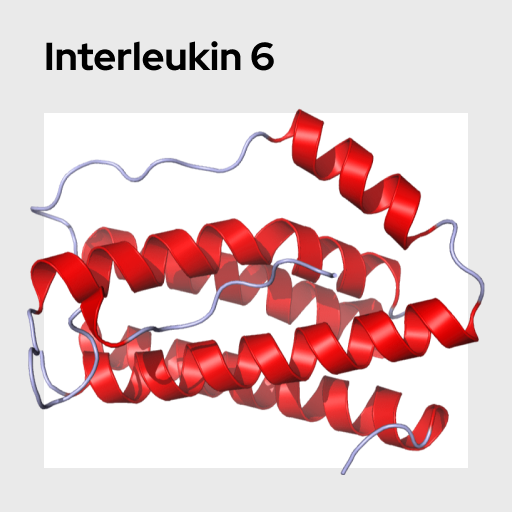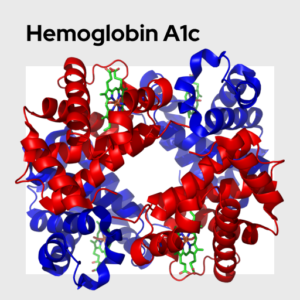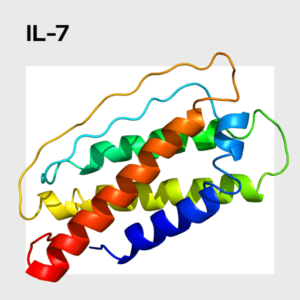Interleukin 6 (IL-6)
Interleukin 6 (IL-6) is also known as B-cell stimulatory factor 2. IL-6 is a pleiotropic cytokine with complex roles in immune function and metabolic disease. It is often used as an index of bodily inflammatory activity, as it is a potent inducer of the acute phase response. However, it should be noted that IL-6 also has anti-inflammatory properties, which may make it an unreliable index of inflammation on its own. IL-6 has been shown to influence the nervous system and may mediate links between immune activation and behavior. In addition to increasing in response to infection, levels of this cytokine also increase in response to psychosocial stress. Levels of IL-6 are typically very low in saliva, which makes this cytokine more difficult to measure in saliva than serum or plasma. This analyte is eligible for multiplexing.
Name: Interleukin 6 (IL-6)
Category: Health & Inflammation
Type of test: Blood + Saliva
Interleukin 6 (IL-6), also known as B-cell stimulatory factor 2, is a small protein that can be classified as both a cytokine and myokine, exhibiting both proinflammatory as well as anti-inflammatory roles. As a cytokine, IL-6 has several important functions, including the recruitment of macrophages during innate immune system activation, regulation of body temperature, initiation of the acute phase response, and stimulating the synthesis of complement factors B and C3. Furthermore, IL-6 binds to the ubiquitous gp130 receptor, inducing inflammation and preventing apoptosis of T cells, as well as maintaining proinflammatory Th17 cells. These local effects aid the innate immune system, but pathology associated with IL-6 dysregulation has also been observed. Specifically, IL-6 has been shown to influence Crohn’s disease and rheumatoid arthritis, as well as other inflammatory disorders.
In recent years, IL-6 has emerged as a potential regulator of body weight homeostasis. When an animal's ability to produce IL-6 is removed, adult-onset obesity is often observed indicating that IL-6 participates in the maintenance of healthy body weight. However, chronic inflammation also plays a focal role in the etiology of obesity, suggesting that while IL-6 is necessary for healthy metabolic function, excessive levels may also contribute to metabolic disorders. As a result of these and many other relationships that have been observed, IL-6 is a promising signaling molecule for the study of metabolic disorders.
Interestingly, IL-6 has also been shown to be anti-inflammatory in certain contexts, which conflicts with the traditional assumption that pro- and anti-inflammatory activity is mutually exclusive among cytokines. As a myokine, for example, it promotes differentiation into anti-inflammatory M2 macrophages, helps to reduce local tissue damage, and reduces atheroma formation in order to maintain endothelial health. It also aids in muscle cell hypertrophy and maintenance, providing another pathway through which it is important for adaptation to exercise.
Levels of IL-6 can be quantified in both blood and saliva. However, levels of IL-6 in saliva are typically very low, making it easier to measure this cytokine in serum / plasma versus saliva samples. The strength of correlations between salivary and serum / plasma levels of IL-6 vary based on a number of different factors, such as whether samples were collected before or after an experimental stressor (i.e., correlation coefficients are often greater after an experimental manipulation).
Tanaka, T., Narazaki, M., & Kishimoto, T. (2014). IL-6 in inflammation, immunity, and disease. Cold Spring Harbor Perspectives in Biology, 6, a016295. https://doi.org/10.1101/cshperspect.a016295
La Fratta, I., Tatangelo, R., Campagna, G., Rizzuto, A., Franceschelli, S., Ferrone, A., ... & Grilli, A. (2018). The plasmatic and salivary levels of IL-1β, IL-18 and IL-6 are associated to emotional difference during stress in young male. Scientific Reports, 8, 1-10. https://pubmed.ncbi.nlm.nih.gov/29445205/
Slavish, D. C., Graham-Engeland, J. E., Smyth, J. M., & Engeland, C. G. (2015). Salivary markers of inflammation in response to acute stress. Brain, Behavior, and Immunity, 44, 253-269. https://pubmed.ncbi.nlm.nih.gov/25205395/






